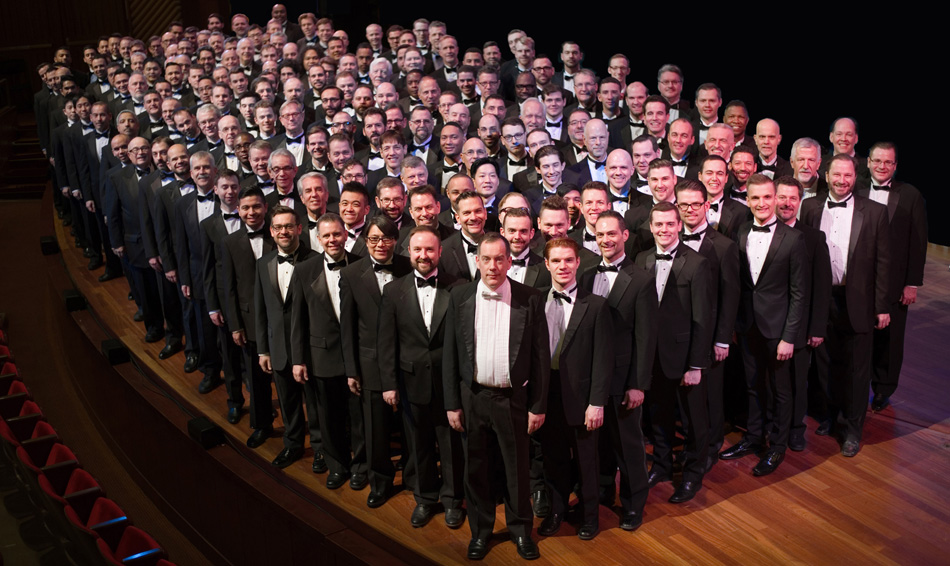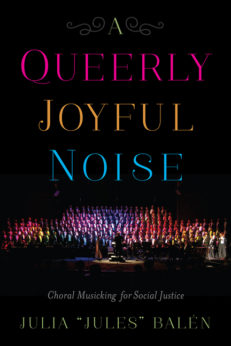
I sang bass with the New York City Gay Men’s Chorus for about a decade, from its founding in 1979 until I moved away in 1990, with a couple of breaks to concentrate on work and writing. During those years, I attended three major LGBT choral festivals—New York, Minneapolis, and Seattle—sharing these experiences with fellow singers, friends, and lovers.
I was excited to note a new book on the LGBT choral movement, A Queerly Joyful Noise, by Julia “Jules” Balén, from Rutgers University Press. I eagerly wrote to request a review copy, imagining that I might even see my name in the book, based on some critical writing on the movement that I produced years ago.
Most of my memories of the movement are magnificent, although as Balén observes, it also had its share of issues and problems inherited from the larger society. As she emphasizes, the fact that queer people (and she does prefer that word) gather together in 400-odd choral groupings in almost three dozen countries exerts a powerful “counterstorying”—a favorite theme of hers—to centuries of the “master narrative” of contempt, loathing, and criminality in many times and places, and contributes instead a positive, upbeat message of solidarity and pride. The empowerment singers feel from asserting their identity and publicly using their voices has literally saved lives—their own and among those who attend LGBT concerts.
If I were to choose a single impression that to me symbolized the mutual support we gave one another in that movement, increasingly so as the AIDS plague started mowing us down, I would recall a rehearsal one summer night when we were introduced to the young man Bruce Hlibok who was going to be our signer for the deaf and hearing-impaired. Bruce had appeared on Broadway as an actor and playwright, elevating public awareness of what the deaf could accomplish despite all the odds against them. Bruce sat not far from me and followed not only the text we were singing but the vibrations from the different sections so as to artistically interpret our words. The song we were rehearsing that night was “He Ain’t Heavy, He’s My Brother,” and as we were learning our music, and as Bruce started practicing his hand and body movements, I soon found I couldn’t read the notes on the page any more through my tears of sadness, joy, and compassion. Bruce worked with us for several seasons until he died of AIDS at age 34 in 1995.
The choruses changed minds. Friends, relatives, and the general public came to concerts and saw LGBT people making glorious sounds, appearing at benefits for worthy causes, mourning their losses, celebrating victories. LGBT people became humanized, no longer aliens.
Of course, the acceptance was spotty and not all at once. David N. Dinkins became the 106th mayor of New York City, and the first Black person to serve in that office, on Jan. 1, 1990. Within the Communist Party USA, a certain “perestroika” had begun, and “new thinking” was encouraged. Belatedly, on Jan. 30, a letter of mine appeared in the People’s Daily World, antecedent to today’s online People’s World, criticizing the paper for its “old thinking” on the gay question. On Jan. 4, PDW carried a full-page article about the “Grand ‘mosaic’ at Dinkins’ inauguration,” emphasizing the “diverse crowd” in attendance, but nowhere in this “mosaic” found fit to mention the gay and lesbian presence. This, despite the fact that the 150-strong New York City Gay Men’s Chorus was there to sing the city’s theme song, “New York, New York,” and was listed on the official inaugural program. You couldn’t miss them.
“I can’t help feeling that years of training in the art of denying gay and lesbian visibility and participation in the reordering of our society will take a long time to overcome,” I concluded in that letter, “unless some firm editorial leadership is provided for your writers.” It may have taken the demise of the Soviet Union, famously repressive toward its LGBT community, for the CPUSA in time to fully reverse its own homophobia. Those days are happily far behind us now.
I was expecting in A Queerly Joyful Noise a history of the LGBT choral movement—such as one my friends had long urged me to write—that would certainly have recounted the fierce resistance from the American Choral Directors Association (ACDA). Gay choruses were winning prizes at regional conventions, producing stunning recordings, commissioning new music from prominent composers, and appearing in the nation’s major concert halls. But the ACDA official organ, Choral Journal, apparently run by evangelical church musicians, refused to print the word “Gay” in chorus names and in other ways ignored the growth of this new force in choral singing.
Eventually it took a lawsuit brought by the Gay and Lesbian Association of Choruses (GALA), championed by the ACLU, to force ACDA to stop discriminating against its own dues-paying member choruses, and as part of the agreement, to publish a long piece about GALA’s background and progress in the Choral Journal, which I was commissioned to write. That article, “GALA: The Lesbian and Gay Community of Song,” which produced a firestorm of responses pro and con in successive issues, appeared in the April 1990 issue. That’s why I believed I’d likely find my name in Balén’s book, and didn’t.
So if A Queerly Joyful Noise is not a history, what is it? Its subtitle is “Choral Musicking for Social Justice,” and that is the clue. Balén is described, in “About the Author,” thus: “With a PhD in comparative cultural and literary studies, Balén focuses on issues of empowerment and power relations across social differences and their intersections in ways that integrate theory and practice.” In other words, she’s an academic, and the book reads like a doctoral dissertation. “Musicking,” the process and context in which music is produced, is hardly a word in common parlance.
I recently came across an interview with writer Daniel Mendelsohn. He says: “I do a tremendous amount of research. I was trained as an academic. One mentor said to me: You can’t write anything until you’ve read everything.” Balén’s bibliography is extensive in references both to sociology sources about groups for advocacy and change and to the websites of several choruses. She footnotes these sources in meticulous and repetitive detail.
Balén is interested in how choruses define themselves, how they view their community, what tensions exist along certain fault lines of openness, race, religion, and gender, and what comparisons can be made between this choral movement and, say, labor and civil rights choruses, church choirs and topical singing groups. She goes into several of the other major LGBT institutions such as Pride marches and festivals, queer community centers, the queer sports and religious movements, by way of setting forth what makes choruses a distinct form of expression. One hallmark of her book is a frequent tendency toward long, i.e., several pages’ worth of digressions, and her text, apart from the academic apparatus, is only 171 pages.
This book was researched as a scholarly project, as she states in her appendix on methodology. Her Institutional Review Board required anonymity in her interviews, which she admits she didn’t prefer. The resulting book is bland and bloodless insofar as vivid personalities who built and sustained the movement barely make an appearance—not even, for example, Gary Miller, whom I knew well as longtime musical director of the NYCGMC.
Controversies are flattened out: To take another personal example, my own beef with the sheer amount of religious and Christmas music the choruses regularly programmed, a subject I wrote about in an op-ed piece in The Advocate (Dec. 8, 1987), which also does not turn up in Balén’s bibliography.
The author includes five pages analyzing one anonymous LGBTIQA chorus’ takeoff on West Side Story, but otherwise establishes little connection between gay music lovers and the Broadway musical. And apart from WSS, she doesn’t reflect upon the music created before the queer choral movement came along, by gay composers whose subtexts and choices of lyrics (such as poems by Walt Whitman) often indicated pointed social critiques and visionary futures. The ten-year career of the five-man gay a cappella touring and recording group The Flirtations, which emerged out of the gay choruses, goes unmentioned.
I wonder, too, why the author paid little or no attention to the many other examples of same-gender musicking, such as Gregorian chant, university choirs in the pre-coed era, and smaller ensembles like the Whiffenpoofs, barbershop and the Sweet Adelines, to probe for possible queer meaning.
There are far too many typos and grammatical errors for a university press publication! On one page (135) African-American cultural icons Cornel West and Marian Anderson are both misspelled.
To her credit, Balén does give special weight to women’s and mixed choruses, which have often been neglected in this discussion. The movement now also has a burgeoning youth and trans component, but much of that development took place after she completed her research, so she only glancingly refers to it. As many of her sources are online, a more interactive way of reading this book might be in digital form.
The three promotional blurbs on the back of Balén’s book are by Robin L. Godfrey, Dr. Timothy Seelig, and Dr. Catherine Roma, all in the leadership of the LGBT choral movement. It’s easy to understand why certain people who have been instrumental in guiding the movement thus far would be enthusiastic about a book that deeply probes the social context for their life’s work. If you happen to be thinking about forming an LGBT chorus in your town, it might serve you well to study Balén’s treatise for useful direction. Others looking for a more comprehensive, historical treatment will probably be disappointed and put off by the dissertation-like research language.
It’s a complicated subject with a lot of moving ideas and parts. A real history of the movement could still be written, and should be while many of the founding generation are still with us, but for its true collective emotional significance, maybe someday a skillfully written novel will focus on this world and bring it to life.
A Queerly Joyful Noise: Choral Musicking for Social Justice
By Julia “Jules” Balén
Rutgers University Press, 2017
211 pages, with 15 illustrations, acknowledgments, appendix, notes, bibliography, index.
ISBN 978-0-8135-8838-4
available in several formats
$24.95










